The night sky holds endless wonders, from the craters of the Moon to distant galaxies swirling billions of light-years away. For anyone captivated by the cosmos, owning a telescope opens up a universe of possibilities. However, choosing the right instrument can feel daunting, especially if you’re just starting out. Finding the best amateur astronomer telescope involves balancing performance, ease of use, portability, and budget. This guide cuts through the jargon and provides expert recommendations for 2025 to help you embark on your celestial journey.
May 2025 brings opportunities like the Flower Moon on May 12, a spectacle enhanced through the lens of a good telescope. As moonlight wanes later in the month, observe the vibrant hues of stars – the blue-white of the Summer Triangle, the orange glow of Arcturus, and the reddish tint of Antares. Planetary enthusiasts will appreciate a quality telescope for viewing Saturn’s pre-dawn appearances, notably alongside the crescent Moon on May 22.
Whether you’re a complete beginner or an experienced enthusiast, selecting the ideal telescope is crucial for maximizing your observing experience. This guide explores top models that represent the best amateur astronomer telescope options across various categories. Getting started in amateur astronomy can be incredibly rewarding, and having a reliable amateur astronomy telescope is key to unlocking the universe’s secrets.
Here are some of the top telescopes we recommend for amateur astronomers in 2025:
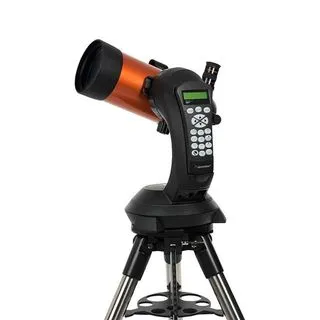
Celestron NexStar 4SE telescope on a white backgroundBest for beginners
Celestron NexStar 4SE
Best for beginners
A superb choice for those new to stargazing, this Celestron NexStar 4SE is straightforward to set up and use, provides sharp, bright views, and includes helpful features.
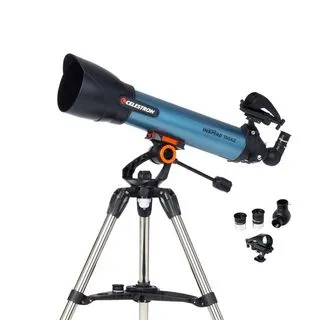 Celestron Inspire 100AZ telescope on a white backgroundBest budget telescope
Celestron Inspire 100AZ telescope on a white backgroundBest budget telescope
Celestron Inspire 100AZ
Best budget telescope
An excellent entry-level option packed with useful accessories, the Celestron Inspire 100AZ is perfect for newcomers stepping into astronomy.
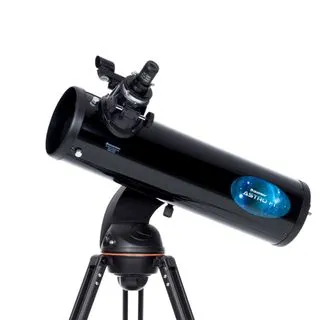 Celestron Astro Fi 130 telescope on a white backgroundBest value for enthusiasts
Celestron Astro Fi 130 telescope on a white backgroundBest value for enthusiasts
Celestron Astro Fi 130
Best value for enthusiasts
Offering impressive performance and features for its price, the Celestron Astro Fi 130 is a strong contender for enthusiasts seeking great value.
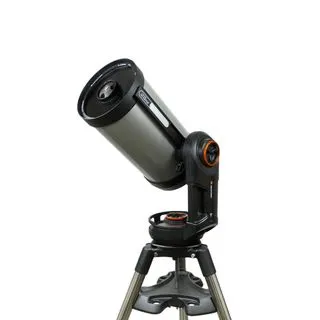 Celestron NexStar Evolution 9.25 telescope on a white backgroundBest premium
Celestron NexStar Evolution 9.25 telescope on a white backgroundBest premium
Celestron NexStar Evolution 9.25
Best premium
Considered an exceptional instrument, this telescope is simple to set up and delivers breathtaking views, suitable for even experienced astronomers.
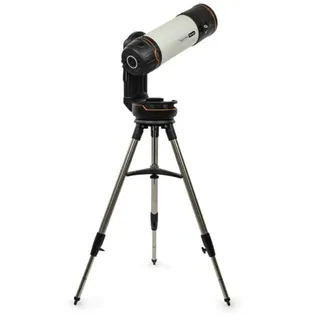 Celestron Origin on a tripod on a white backgroundBest for astrophotography
Celestron Origin on a tripod on a white backgroundBest for astrophotography
Celestron Origin Intelligent Home Observatory
Best for astrophotography
This innovative smart telescope captures stunning deep-sky images rapidly, though it’s specialized and not a general-purpose telescope.
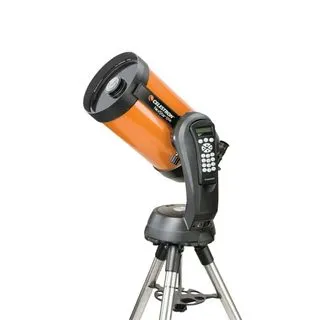 Celestron NexStar 8SE telescope on a white backgroundBest motorized telescope
Celestron NexStar 8SE telescope on a white backgroundBest motorized telescope
Celestron NexStar 8SE
Best motorized telescope
An excellent choice for all experience levels, this scope is incredibly easy to use yet powerful enough for deep space exploration and potential astrophotography.
Load the next 5 products ↴
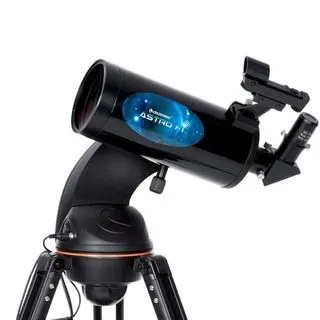 Celestron Astro Fi 102 telescope on a white backgroundBest for portability
Celestron Astro Fi 102 telescope on a white backgroundBest for portability
Celestron Astro Fi 102
Best for portability
If you need a light, easy-to-transport telescope for observing from dark sky locations away from urban light pollution, this is a strong contender.
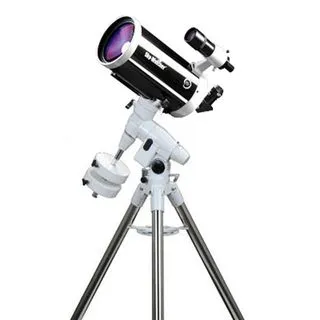 Sky-Watcher Skymax 150 PRO on a white backgroundBest for accessories
Sky-Watcher Skymax 150 PRO on a white backgroundBest for accessories
Sky-Watcher Skymax 150 PRO
Best for accessories
This telescope is versatile for imaging various celestial objects and offers excellent optical quality, plus it accommodates a range of accessories.
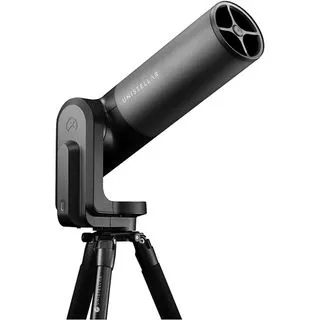 Unistellar eQuinox 2 Smart TelescopeBest smart telescope
Unistellar eQuinox 2 Smart TelescopeBest smart telescope
Unistellar Equinox 2
Best smart telescope
A high-end option featuring Unistellar’s most advanced technology, it includes a reliable app and Smart Light Reduction for urban observing.
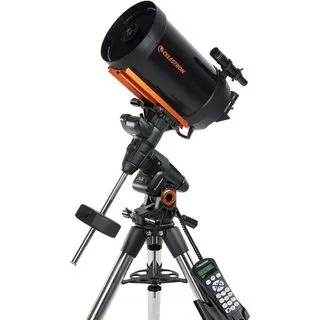 Celestron Advanced VX 8 EdgeHD Schmidt-Cassegrain TelescopeBest for deep space
Celestron Advanced VX 8 EdgeHD Schmidt-Cassegrain TelescopeBest for deep space
Celestron Advanced VX 8 EdgeHD
Best for deep space
An excellent choice for seasoned astronomers, its Edge HD technology makes it outstanding for astrophotography of deep-sky objects.
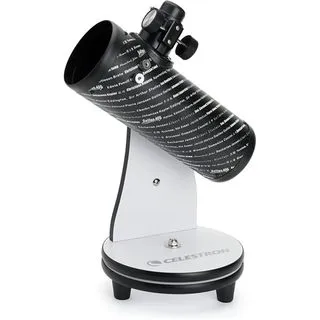 Celestron Classic Firstscope 76mm Tabletop TelescopeBest for kids
Celestron Classic Firstscope 76mm Tabletop TelescopeBest for kids
Celestron FirstScope 76 Tabletop telescope
Best for kids
An ideal starting point for young or novice astronomers, this tabletop scope is easy to handle and set up, though less powerful than larger models.
Best Amateur Astronomer Telescope Recommendations for 2025
Best for beginners
Image 1 of 7
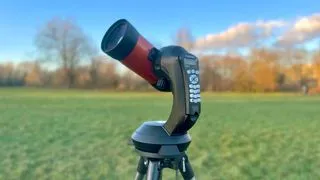 Celestron NexStar 4SE set up outdoors, ideal for amateur astronomy beginners
Celestron NexStar 4SE set up outdoors, ideal for amateur astronomy beginners
The Celestron Nexstar 4SE is quick and easy to set up, making it perfect for beginners wanting a quality Go-To telescope. (Image credit: Jonathan Lansley-Gordon)
![]() Celestron NexStar 4SE with GoTo technology tracking celestial objects
Celestron NexStar 4SE with GoTo technology tracking celestial objects
The Celestron NexStar 4SE’s GoTo technology allows easy finding and tracking of celestial objects, great for new amateur astronomers. (Image credit: Jonathan Lansley-Gordon)
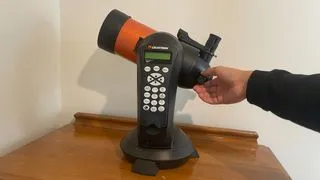 Close up view of the Celestron NexStar 4SE hand controller
Close up view of the Celestron NexStar 4SE hand controller
This beginner-friendly telescope will fit nicely on your tabletop for convenient observing sessions. (Image credit: Jonathan Lansley-Gordon)
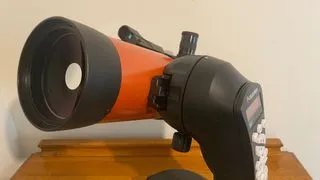 Close up view of the Celestron NexStar 4SE fork arm mount
Close up view of the Celestron NexStar 4SE fork arm mount
The NexStar 4SE features a 4-inch (102mm) aperture and a focal length of 1325mm, suitable for beginner astronomers. (Image credit: Jonathan Lansley-Gordon)
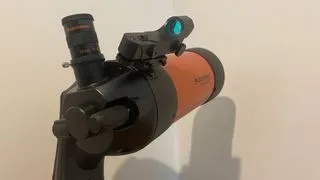 Close up of the Celestron NexStar 4SE finderscope
Close up of the Celestron NexStar 4SE finderscope
The 4SE includes a built-in star diagonal with a flip mirror for ease of use. (Image credit: Jonathan Lansley-Gordon)
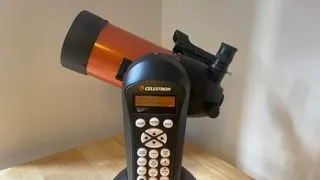 Side view of the Celestron NexStar 4SE telescope on a wooden table
Side view of the Celestron NexStar 4SE telescope on a wooden table
Celestron’s distinct orange tube design is easily recognizable. (Image credit: Jonathan Lansley-Gordon)
 Amateur astronomer operating the Celestron NexStar 4SE in the backyard
Amateur astronomer operating the Celestron NexStar 4SE in the backyard
Setting up the Celestron 4SE is simple, although transport can be cumbersome due to its size. (Image credit: Jonathan Lansley-Gordon)
Celestron NexStar 4SE
Best for finding planets: Effortlessly locates celestial objects using Celestron’s SkyAlign technology.
Specifications
Optical design: Maksutov-Cassegrain
Mount type: Computerized Alt-Azimuth
Aperture: 4-inches / 102mm
Focal length: 1325mm
Highest useful magnification: 241x
Lowest useful magnification: 15x
Supplied eyepieces: 25mm
Weight: 23 lbs (10.44kg) fully assembled
Reasons to buy
- Quick, straightforward setup
- Automatically finds celestial objects (GoTo)
- High-quality, durable construction
- No mirror collimation needed
Reasons to avoid
- Restricted field of view
- Not highly portable
- Limited included accessories
Buy it if:
✅ You’re investing in your first telescope: This telescope is designed for ease of use and quick setup, making it perfect for astronomers just starting out.
✅ You want GoTo technology: Its automated system finds and tracks celestial objects with minimal prior knowledge required.
Don’t buy it if:
❌ You need a travel telescope: Its weight and non-folding tripod make it less suitable for taking on the go.
The bottom line:
🔎 Celestron NexStar 4SE: A solid choice among the best amateur astronomer telescope options for beginners. It excels at providing clear, bright views of planets and the Moon with push-button simplicity, though its portability is limited. ★★★★
The Celestron NexStar 4SE stands out as a fantastic entry point for amateur astronomers, primarily due to its fully computerized mount and Celestron’s intuitive SkyAlign technology. This system uses your date, time, and location to automatically locate and track a wide range of celestial targets, significantly simplifying the stargazing process for newcomers.
With a 4-inch (102mm) aperture and a long 1,325mm focal length, the NexStar 4SE delivers sharp views of planets and other bright objects. However, this optical combination results in a relatively narrow 1.2-degree field of view, which can make fitting larger deep-sky objects challenging. The telescope includes a 25mm Plossl eyepiece, but adding a 32mm eyepiece and a Barlow lens can enhance your viewing options, especially when utilizing its 241x highest useful magnification.
Its robust design contributes to its stability but also its weight. At 23 lbs (10.4 kg), it’s heavier than many portable options, and its tripod doesn’t fully collapse, further limiting its travel-friendliness. A key consideration is its power consumption; the GoTo mount quickly depletes 8x AA batteries, making an external power source highly recommended. This makes the NexStar 4SE ideally suited as a good backyard telescope for observations from a fixed location.
| Attributes | Notes |
|---|---|
| Design | Solid, sturdy build with signature orange tube. |
| Performance | Excellent for observing the Moon and planets. |
| Functionality | Simple setup, GoTo helpful, but alignment can vary. |
Best budget telescope
Image 1 of 7
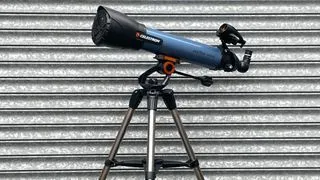 Celestron Inspire 100AZ refractor telescope against corrugated iron, a good budget telescope for amateur astronomers
Celestron Inspire 100AZ refractor telescope against corrugated iron, a good budget telescope for amateur astronomers
The Celestron Inspire 100AZ comes with helpful accessories, though upgrading the eyepieces is recommended for better performance. (Image credit: Jamie Carter)
 Close-up of the focusing knob on the Celestron Inspire 100AZ tube
Close-up of the focusing knob on the Celestron Inspire 100AZ tube
This budget telescope is easy for beginners to set up and operate. (Image credit: Jamie Carter)
 Small red flashlight stored in the Celestron Inspire 100AZ tripod
Small red flashlight stored in the Celestron Inspire 100AZ tripod
A built-in red flashlight illuminates the accessory tray, preserving night vision. (Image credit: Jamie Carter)
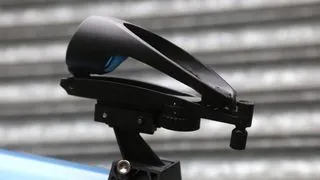 StarPointer Pro finderscope attached to the Celestron Inspire 100AZ
StarPointer Pro finderscope attached to the Celestron Inspire 100AZ
The StarPointer Pro finderscope with bullseye reticle aids in locating celestial objects. (Image credit: Jamie Carter)
 Smartphone adapter using the lens cap of the Celestron Inspire 100AZ
Smartphone adapter using the lens cap of the Celestron Inspire 100AZ
The clever lens cap doubles as a smartphone holder for basic astrophotography. (Image credit: Jamie Carter)
 Demonstration of the Celestron Inspire 100AZ smartphone holder with phone attached
Demonstration of the Celestron Inspire 100AZ smartphone holder with phone attached
A smartphone attaches to the lens cap holder with elastic cords. (Image credit: Jamie Carter)
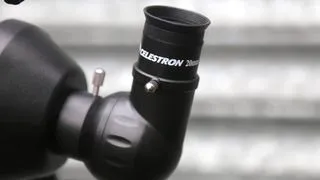 Side view of the Celestron Inspire 100AZ star diagonal
Side view of the Celestron Inspire 100AZ star diagonal
The Celestron Inspire 100AZ includes 20 mm and 10 mm Kellner eyepieces. (Image credit: Jamie Carter)
Celestron Inspire 100AZ Refractor
Best budget telescope for budding skywatchers looking for a quick start.
Specifications
Optical design: Refractor
Mount type: Alt-azimuth
Aperture: 3.94-inches / 100mm
Focal length: 660mm
Highest useful magnification: 241x
Lowest useful magnification: 15x
Supplied eyepieces: 10mm, 25mm
Weight: 20 lbs (9.07kg)
Reasons to buy
- Clear views of planets and the Moon
- Convenient smartphone adapter included
- Integrated red light feature
- Lightweight frame
Reasons to avoid
- Mount bearings lack precision
- Some chromatic aberration present
- Not suitable for solar observing
Buy it if:
✅ You are a beginner: Its straightforward setup and usability make it an excellent first telescope.
✅ You want to try smartphone astrophotography: The lens cap ingeniously converts into a smartphone holder for capturing sky images.
Don’t buy it if:
❌ You need automated object finding: This model lacks GoTo technology, requiring manual locating (perhaps with a stargazing app).
❌ You seek detailed deep-sky views: While it performs well on brighter objects, distant deep-sky subjects may appear less impressive.
The bottom line:
🔎 Celestron Inspire 100az: Geared towards beginners and those upgrading from simpler scopes, this 4-inch refractor excels at lunar and planetary observations. It’s one of the best amateur astronomer telescope options on a tighter budget. ★★★★
The Celestron Inspire 100AZ is a fantastic entry point for beginners, striking a good balance between user-friendly features, sturdy construction, and affordability. It’s priced competitively among entry-level telescopes.
This achromatic refractor boasts a 4-inch/100mm aperture and a relatively short 660mm focal length. It’s designed for home observation of planets, the Moon, and some brighter deep-sky objects. It sits on a simple altazimuth mount, offering easy side-to-side and up-and-down movement, controlled by a panhandle.
The 100mm aperture collects a respectable amount of light, allowing for views of faint celestial objects like nebulas and galaxies, though they won’t be highly detailed. The focal length provides decent magnification for closer objects like planets. During our review, we noted a small amount of false color (purple fringing) around bright objects and slight blurring towards the field edges. The blurring can be improved by investing in better eyepieces. The false color is typical for achromatic refractors and usually isn’t a dealbreaker for casual observing.
The Inspire 100AZ comes with useful accessories, including two eyepieces, a red LED flashlight (to preserve night vision), an accessory tray, and a StarPointer Pro finderscope. A standout feature is the lens cap that transforms into a smartphone adapter, allowing you to easily attach your phone to capture quick photos of what you see.
| Attributes | Notes |
|---|---|
| Design | Fairly lightweight, sturdy build. |
| Performance | Particularly strong performance on lunar views. |
| Functionality | Simple to set up and pack down, great for beginners. |
Best value for enthusiasts
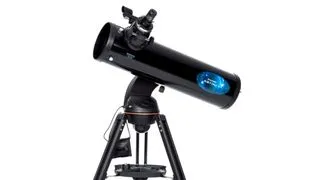 Celestron Astro Fi 130 on a white background, a valuable amateur astronomy telescope
Celestron Astro Fi 130 on a white background, a valuable amateur astronomy telescope
The Celestron Astro Fi 130’s wide field of view is great for observing large galaxies without constant repositioning. (Image credit: B&H Photo)
Celestron Astro Fi 130
Best value enthusiast telescope: A feature-rich guide to the night sky at a competitive price.
Specifications
Optical design: Newtonian Reflector
Mount type: Computerized altitude-azimuth single fork
Aperture: 5.19-inches / 130mm
Focal length: 650mm
Highest useful magnification: 307x
Lowest useful magnification: 19x
Supplied eyepieces: 25mm and 10mm
Weight: 18 lbs (8.6kg)
Reasons to buy
- Affordable for its feature set
- Excellent entry-level GoTo scope
- Vixen dovetail for mount flexibility
- Portable design
- App recommends observing targets
- Automated object finding
Reasons to avoid
- Stock eyepieces limit performance
- Focuser quality could be better
- Battery drains quickly (especially in cold)
- Requires app for full functionality
Buy it if:
✅ You want a beginner-friendly, portable, easy-to-use telescope: It’s a great entry-level option with automated target finding, perfect for on-the-go observations.
Don’t buy it if:
❌ You prefer a ‘traditional’ non-computerized scope: This telescope is heavily reliant on its companion app for operation.
The bottom line:
🔎 Celestron Astro Fi 130: A highly capable telescope offering exceptional value. It’s well-equipped for beginners but benefits from eyepiece upgrades. Its reliance on battery power and cold-weather performance are minor drawbacks. ★★★½
The Celestron Astro Fi 130 stands out for its combination of capability and affordability, making it a strong contender among the best amateur astronomer telescope options that offer computerized tracking without breaking the bank. This well-built Newtonian reflector features a sturdy aluminum tripod and comes with 10mm and 25mm Kellner eyepieces, providing 65x and 26x magnification respectively, along with a red dot finder.
For optimal viewing, we strongly recommend upgrading the included Kellner eyepieces to better quality Plossl eyepieces. During our review, we also noted that its batteries can drain rapidly in cold conditions, so investing in 12V rechargeable batteries is a sensible move for extended observing sessions.
This telescope is ideal for beginners entering the hobby. Its SkyAlign technology simplifies setup, removing the need for extensive prior knowledge of the night sky. The free Celestron SkyPortal app allows seamless control via your smartphone or tablet, can recommend interesting celestial objects, and guides the computerized mount directly to them.
The Astro Fi 130’s optics provide good views of the Moon, revealing craters and rilles. Planets like Venus and Mars are easily discernible, and we even managed to glimpse the Andromeda Galaxy. Its 130mm aperture and 650mm focal length (f/5) give it a wider field of view compared to some other scopes, making it good for framing larger star clusters and nebulae.
| Attributes | Notes |
|---|---|
| Design | Very sturdy construction for the tube and tripod. |
| Performance | Utilizes SkyAlign for easy setup; good for lunar/planetary views. |
| Functionality | Computerized GoTo via app, but some views can be slightly soft. |
Best premium
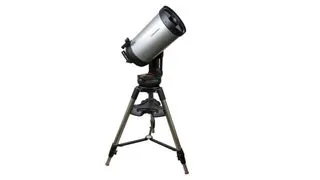 Celestron NexStar Evolution 9.25 on a tripod on a white background, a premium amateur astronomer telescope
Celestron NexStar Evolution 9.25 on a tripod on a white background, a premium amateur astronomer telescope
Automatically track objects across the sky with this high-quality Catadioptric telescope. (Image credit: B&H Photo)
Celestron NexStar Evolution 9.25
Best GoTo scope for seeing the universe in HD, with a premium price point.
Specifications
Optical design: Schmidt-Cassegrain
Mount type: Computerized alt-azimuth fork arm
Aperture: 9.25-inches / 235mm
Focal length: 2350mm
Highest useful magnification: 555x
Lowest useful magnification: 34x
Supplied eyepieces: 13mm, 40mm
Weight: 62.60 lbs (28.39kg)
Reasons to buy
- Crisp views free from defects
- Easy and quick setup
- High-quality, robust design
Reasons to avoid
- Not easily portable — best for backyard use
- Significant investment required
Buy it if:
✅ You want to observe a wide range of celestial objects: Its large aperture provides clear, detailed views of planets, deep-sky objects, and nebulas.
✅ You are an experienced skywatcher: While beginner-friendly in setup, its capabilities are best appreciated by more advanced astronomers seeking comprehensive views.
Don’t buy it if:
❌ Portability is a priority: The Evolution 9.25 is heavy and bulky, making it less suitable for transport away from your observing site.
The bottom line:
🔎 Celestron NexStar Evolution 9.25: An exceptional GoTo telescope, particularly well-suited for experienced skywatchers, matching its premium features with a premium price tag. It’s among the top-tier options for a good backyard telescope. ★★★★½
The Celestron NexStar Evolution 9.25 is a standout premium telescope, providing breathtaking views of the night sky with remarkable clarity. This Schmidt-Cassegrain telescope features a substantial 235mm aperture and a sturdy single-fork arm mount, ensuring stability and tracking precision. The motorized mount includes a rechargeable lithium-ion battery, offering an impressive 10 hours of continuous stargazing on a single charge.
The Evolution 9.25 package comes complete with valuable accessories, including a red dot finderscope, star diagonal, accessory tray, international AC adapter, hand control, and two Plossl eyepieces (13mm and 40mm).
Unlike some entry-level options, the NexStar Evolution 9.25 is a formidable instrument for more advanced and passionate astronomers. While the setup is surprisingly easy even for beginners, its full potential is best unlocked by those with some observing experience. It represents a significant investment, but the quality of views and features justifies the cost for serious hobbyists. This is truly a top-tier hobby telescope.
Astrophotographers will also appreciate this telescope’s motorized mount, capable of accurately tracking celestial objects for long-exposure imaging. It can be seamlessly controlled via the free Celestron SkyPortal app, freeing up your hands during photography sessions.
Despite its impressive design and capabilities, its weight makes it less portable. At over 60 lbs with the mount, it’s best suited for use from a fixed location like a backyard or observatory. However, for static observation, its robust construction and exceptional optical performance more than compensate for the lack of portability.
| Attributes | Notes |
|---|---|
| Design | Bulky, making transport difficult, but very high quality. |
| Performance | Delivers crisp, defect-free views across a wide range of objects. |
| Functionality | Motorized mount is excellent for both visual tracking and imaging. |
Best for astrophotography
Image 1 of 5
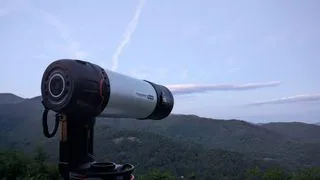 Celestron Origin Intelligent Home Observatory smart telescope in a field, designed for astroimaging
Celestron Origin Intelligent Home Observatory smart telescope in a field, designed for astroimaging
The Celestron Origin has the look of a classic Celestron tube, but lacks an eyepiece, relying on a camera. (Image credit: Future/Brett Tingley)
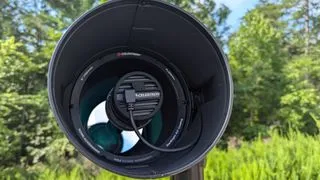 Celestron Origin capturing deep sky images
Celestron Origin capturing deep sky images
A built-in camera within the Celestron Origin allows it to capture beautiful deep-sky photos. (Image credit: Future/Brett Tingley)
 Handles on the Celestron Origin mount for easier carrying
Handles on the Celestron Origin mount for easier carrying
Several integrated handles improve the portability of the Origin’s mount. (Image credit: Future/Brett Tingley)
 Celestron Origin smart telescope used for planetary viewing
Celestron Origin smart telescope used for planetary viewing
While capable of viewing planets like Saturn, focusing on them can sometimes be challenging with the Origin. (Image credit: Future/Brett Tingley)
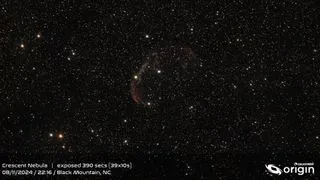 Sharp astro shot of the Crescent Nebula taken with the Celestron Origin
Sharp astro shot of the Crescent Nebula taken with the Celestron Origin
An example of a clear deep-sky image captured by the Celestron Origin without the need for filters. (Image credit: Future/Brett Tingley)
Celestron Origin Intelligent Home Observatory
Best for astrophotography: This smart telescope captures clear deep-sky images in mere seconds.
Specifications
Optical design: Rowe-Ackermann Schmidt Astrograph (RASA)
Mount type: Motorized Alt-azimuth
Aperture: 6-inches / 152mm
Focal length: 335mm
Highest useful magnification: N/A (Digital Zoom)
Lowest useful magnification: N/A (Digital Zoom)
Supplied eyepieces: N/A
Weight: 41.6 lbs (18.6 kg)
Reasons to buy
- Exceptionally clear deep-sky photos captured instantly
- Rapid setup time
- User-friendly, effective companion app
- Automatically stacks and processes images
Reasons to avoid
- Not optimized for all types of celestial objects (e.g., planets)
- Relatively large and heavy
Buy it if:
✅ You want an automated observing and imaging system: Focusing, tracking, object finding, and image processing are all handled autonomously.
✅ Your primary interest is deep-sky imaging: The Origin excels at capturing beautiful images of nebulas and galaxies quickly, even with minimal experience.
Don’t buy it if:
❌ You prefer a traditional telescope with an eyepiece: This smart telescope provides views and images solely on a connected mobile device.
❌ You are on a tight budget: With a price point around $4,000, this is a significant investment.
The bottom line:
🔎 Celestron Origin Intelligent Home Observatory: A high-cost, innovative smart telescope that automates much of the stargazing process, producing stunning deep-sky photos rapidly. It’s not a traditional amateur astronomy telescope but a dedicated astroimaging system. ★★★★½
The Celestron Origin Intelligent Home Observatory redefines the experience of using a telescope, particularly for astrophotography. Unlike conventional telescopes, it replaces the eyepiece with a built-in camera, delivering views and images directly to a connected mobile device.
This results in remarkably clear images of deep-sky objects and distant galaxies, even in areas plagued by light pollution. The system captures and stacks multiple images in real-time, enhancing brightness and detail as you watch. While this approach might not appeal to traditionalists, it’s highly effective, especially the Smart Light Pollution Reduction feature. We found the ‘snapshot’ mode, allowing manual setting adjustments for single photos, to be a valuable addition. However, we found imaging planets less straightforward, suggesting it might require more practice or specific settings.
Beginners will find the Origin remarkably accessible thanks to its quick, easy setup and automated functions (focusing, tracking, finding objects). You don’t need prior astronomy experience to start using it. The intuitive companion app provides a ‘Planetarium View’ and allows you to select objects for the telescope to automatically slew to.
The Celestron Origin visually resembles a standard telescope but lacks an eyepiece. It is also on the heavier side, making it less ideal for portability. The roughly $4,000 price tag is substantial, but for those with the budget who prioritize easy, high-quality deep-sky imaging, this smart telescope is a compelling option.
| Attributes | Notes |
|---|---|
| Design | Bulky, but designed with useful carrying features on the mount. |
| Performance | Excels at producing clear, beautiful photos of deep-sky objects quickly. |
| Functionality | Automated GoTo and imaging; requires a mobile device, no eyepiece. |
Best motorized telescope
Image 1 of 7
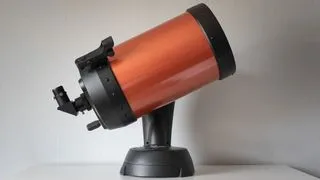 Celestron NexStar 8SE motorized telescope
Celestron NexStar 8SE motorized telescope
The uncluttered design of the 8SE makes it easy to handle without damaging components. (Image credit: Jason Parnell-Brookes)
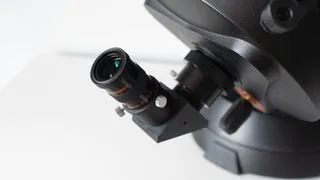 Celestron NexStar 8SE 25mm eyepiece view
Celestron NexStar 8SE 25mm eyepiece view
The NexStar 8SE includes a 25mm eyepiece; a 10mm eyepiece is recommended for closer views. (Image credit: Jason Parnell-Brookes)
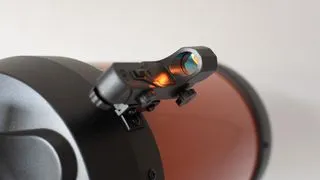 Basic yet effective finderscope on the Celestron NexStar 8SE
Basic yet effective finderscope on the Celestron NexStar 8SE
Although basic in appearance, the included finderscope for the NexStar 8SE is surprisingly functional. (Image credit: Jason Parnell-Brookes)
 Large focus knob on the Celestron NexStar 8SE
Large focus knob on the Celestron NexStar 8SE
The large focus knob is easy to locate and operate even in the dark or while wearing gloves. (Image credit: Jason Parnell-Brookes)
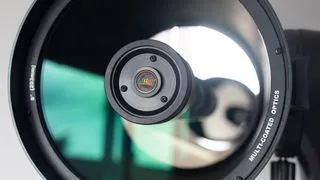 Celestron NexStar 8SE 203.2mm aperture lens
Celestron NexStar 8SE 203.2mm aperture lens
The 203.2mm aperture lens of the NexStar 8SE enables breathtaking views of deep-sky objects. (Image credit: Jason Parnell-Brookes)
 Easy-to-use hand controller for the Celestron NexStar 8SE
Easy-to-use hand controller for the Celestron NexStar 8SE
The controls on the NexStar 8SE hand controller are straightforward, even for beginners. (Image credit: Jason Parnell-Brookes)
 Celestron NexStar 8SE controlled by its included hand controller
Celestron NexStar 8SE controlled by its included hand controller
The Celestron NexStar 8SE is controlled via its in-built hand controller, not a smartphone app. (Image credit: Jason Parnell-Brookes)
Celestron NexStar 8SE
Best motorized scope: Excellent clarity and detail for deep space observing and astrophotography.
Specifications
Optical design: Schmidt-Cassegrain
Mount type: Computerized alt-azimuth fork arm
Aperture: 8-inches / 203mm
Focal length: 2032mm
Highest useful magnification: 480x
Lowest useful magnification: 29x
Supplied eyepieces: 25mm
Weight: 32 lbs (14.48kg)
Reasons to buy
- Provides incredibly bright views
- Sharpness maintained across the entire field of view
- Excellent value despite the price
Reasons to avoid
- Price point may be high for some beginners
- Minor lag when slewing with the remote
Buy it if:
✅ You seek a durable, long-term telescope: Often called ‘The World’s Most Beloved Telescope,’ it’s built to last for decades.
✅ You intend to pursue astrophotography: Its smooth and accurate tracking capability makes it ideal for capturing stunning deep-sky images.
Don’t buy it if:
❌ You are on a strict budget: While offering great value, its price is a significant investment compared to entry-level options.
The bottom line:
🔎 Celestron NexStar 8SE: An outstanding telescope suitable for beginners, intermediate, and advanced astronomers alike, offering powerful optics and ease of use. Its cost is the main barrier for newcomers, but its performance and longevity make it one of the best amateur astronomer telescope options available. ★★★★½
The Celestron NexStar 8SE is one of the most versatile and popular telescopes on the market, representing an ideal instrument to grow with as an amateur astronomer. It’s user-friendly enough for complete beginners, requiring no prior knowledge of the night sky, yet its superb optics satisfy experienced observers. Although the price is higher than entry-level models, its performance and durability make it a worthwhile investment for a serious hobby telescope.
The Celestron SkyAlign process makes alignment straightforward using three bright stars. Once aligned, the entire operation is automated via the handheld remote. You simply select a celestial object from the categorized database (solar system, stars, deep sky) or choose the ‘sky tour’ for automated suggestions based on your location.
With an 8-inch aperture and Schmidt-Cassegrain design, this telescope gathers a large amount of light, providing bright, clear views of objects both within and beyond our solar system. The compact catadioptric design keeps the distinctive orange tube relatively short, enhancing its portability compared to many telescopes with similar aperture.
In our review, we were particularly impressed by the smooth and accurate tracking of the motorized fork arm mount, noting its suitability for long-exposure astrophotography. The telescope does require 8x AA batteries, so using rechargeable batteries is highly recommended for cost-effectiveness during long observing sessions. Given its capabilities and build quality, the Celestron NexStar 8SE is a telescope you are unlikely to outgrow quickly.
| Attributes | Notes |
|---|---|
| Design | Can be transported assembled, robust build. |
| Performance | Outstanding optics; alignment can be slightly challenging initially. |
| Functionality | Easy to assemble/disassemble; motorized mount great for imaging. |
Best for portability
Image 1 of 7
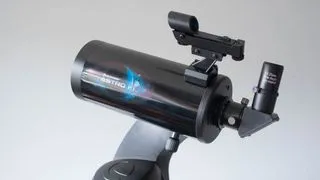 Celestron Astro Fi 102 on a white background, a portable amateur astronomy telescope
Celestron Astro Fi 102 on a white background, a portable amateur astronomy telescope
While perhaps not the most aesthetically premium, the Astro Fi 102 offers good optical quality for its portability. (Image credit: Jason Parnell-Brookes)
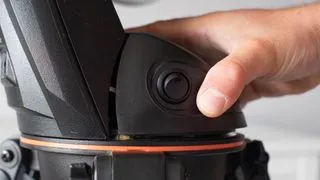 Celestron Astro Fi 102, lightweight and portable telescope
Celestron Astro Fi 102, lightweight and portable telescope
Despite its portability, the finish of this telescope doesn’t feel particularly premium. (Image credit: Jason Parnell-Brookes)
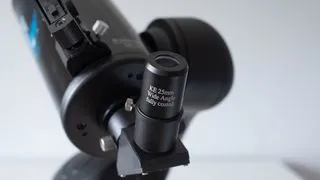 Included eyepieces for the Celestron Astro Fi 102
Included eyepieces for the Celestron Astro Fi 102
The telescope comes with 25mm and 10mm eyepieces, offering 53x and 132.5x magnification respectively. (Image credit: Jason Parnell-Brookes)
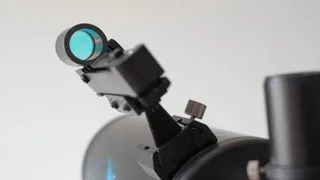 Finderscope attached to the Celestron Astro Fi 102 tube
Finderscope attached to the Celestron Astro Fi 102 tube
Attaching the finderscope to the telescope tube is a straightforward process. (Image credit: Jason Parnell-Brookes)
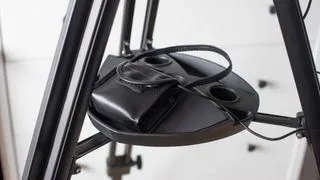 Accessory tray on the Celestron Astro Fi 102 tripod
Accessory tray on the Celestron Astro Fi 102 tripod
The accessory tray is convenient for keeping eyepieces and other gear organized in the dark. (Image credit: Jason Parnell-Brookes)
 Battery pack connection for the Celestron Astro Fi 102
Battery pack connection for the Celestron Astro Fi 102
The battery pack requires 8 AA batteries, and the cable connection could be more robust. (Image credit: Jason Parnell-Brookes)
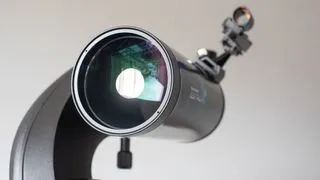 Optical tube assembly dimensions of the Celestron Astro Fi 102
Optical tube assembly dimensions of the Celestron Astro Fi 102
The compact size of the optical tube assembly contributes to the telescope’s portability. (Image credit: Jason Parnell-Brookes)
Celestron Astro Fi 102
Best lightweight and portable Go-To mount scope for beginner sky watchers.
Specifications
Optical design: Maksutov-Cassegrain
Mount type: Computerized Alt-Azimuth Single Fork Arm
Aperture: 4.0-inches / 102mm
Focal length: 1325mm
Highest useful magnification: Up to 100x with digital zoom
Lowest useful magnification: 15x
Supplied eyepieces: 25mm and 10mm
Weight: 6 lbs (2.7kg)
Reasons to buy
- Exceptionally portable due to lightweight design
- Reasonably and fairly priced for its features
- No prior astronomy experience required for operation
Reasons to avoid
- Optics could be sharper
- Included tripod is not the sturdiest
- Doesn’t feel like a premium product to the touch
Buy it if:
✅ You plan to travel with your telescope: It’s our top recommendation for portability, ideal for camping trips or visiting dark sky locations.
✅ You are a beginner: Excellent for casual viewing of the Moon and planets.
Don’t buy it if:
❌ You prioritize high-quality components: While adequate for basic astronomy, some components like the tripod and focuser feel less premium.
The bottom line:
🔎 Celestron Astro Fi 102: Best suited for observing the Moon and planets, this telescope is a great portable option for beginners. Setup can be a bit tricky initially, and the quality isn’t top-tier, but it serves its purpose well. ★★★½
The Celestron Astro Fi 102 offers significant advantages for newcomers to astronomy, particularly its portability and ease of use with a motorized Go-To mount. It’s relatively simple to set up and operates via a companion app, automatically slewing to your chosen target. The price point is quite affordable for a Maksutov-Cassegrain with computerized features, making it an accessible best amateur astronomer telescope for those prioritizing convenience and mobility.
Its lightweight design (only 6 lbs/2.7kg) makes it extremely easy to carry, which was a major plus in our review. This makes it ideal for transporting to darker locations away from urban light pollution. However, its construction is less robust than pricier scopes and isn’t weather-sealed, so protection from moisture is essential. We also felt a sturdier tripod would enhance stability, as the included one felt a bit flimsy and needed weighting down.
Integrated WiFi allows pairing with the Celestron SkyPortal app, which contains a vast database of celestial objects. Beginners can easily navigate the night sky by selecting objects in the app and letting the telescope do the rest.
For its price, the Celestron Astro Fi 102 provides good views of the Moon, its craters, and closer planets like Mars, Saturn, and Jupiter. Under good conditions, you might even glimpse Uranus or Neptune. There is some expected sharpness drop-off towards the field edges, a common characteristic in this price range. The plastic casing is functional but doesn’t provide the same feeling of durability or weather resistance as more expensive, fully-sealed models.
| Attributes | Notes |
|---|---|
| Design | Highly portable; the tripod requires additional stability. |
| Performance | Initial setup has a learning curve, but operation becomes smooth after. |
| Functionality | Extensive database of objects in the SkyPortal app; Wi-Fi enabled GoTo. |
Best for accessories
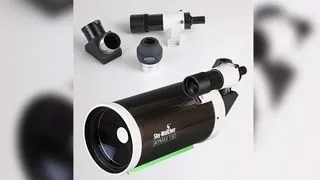 Sky-Watcher Skymax 150 PRO and accessories on a white table, great for astrophotography
Sky-Watcher Skymax 150 PRO and accessories on a white table, great for astrophotography
This telescope is versatile for capturing everything from planets to deep-sky subjects and accommodates many accessories. (Image credit: Amazon)
Sky-Watcher Skymax 150 PRO
Best for accessories: The Skymax 150 PRO is designed to easily attach CCD or DSLR cameras, filter wheels, and other add-ons.
Specifications
Optical design: Maksutov-Cassegrain
Mount type: Equatorial (EQ-5 Pro)
Aperture: 5.90-inches / 150mm
Focal length: 1800mm
Highest useful magnification: 450x
Lowest useful magnification: 36x
Supplied eyepieces: 28 mm
Weight: 13.23 lbs (6kg)
Reasons to buy
- High-quality, lightweight construction
- Excellent optical performance
- Versatile for various types of astrophotography
Reasons to avoid
- Tripod not always included
- Comes with only one eyepiece
Buy it if:
✅ You intend to travel for astrophotography: Its manageable weight makes it easy to transport to dark sky sites.
✅ Your primary focus is astrophotography: Recommended as one of the best options for capturing celestial images due to its optics and mount compatibility.
Don’t buy it if:
❌ You are looking for a sophisticated all-in-one smart scope: This is a traditional telescope requiring external equipment for imaging.
The bottom line:
🔎 Sky-Watcher Skymax 150 PRO: Perfect for astrophotographers who value quality optics, a solid build, and the ability to easily add accessories. It’s highly portable for imaging trips, though check if a tripod is included. ★★★★
The Sky-Watcher Skymax 150 is an excellent choice for amateur astrophotographers, largely thanks to its high-quality Maksutov-Cassegrain design and compatibility with equatorial mounts like the EQ-5 Pro, suitable for both short and long exposures.
Weighing in at just 13.23 lbs (6kg), this telescope is easily transportable to different observing locations, a key factor for astrophotography which often requires traveling to darker skies. Its design works well with many equatorial mounts and is built to accommodate accessories such as CCD or DSLR cameras, filter wheels, and more. It also features a Vixen-style dovetail plate for convenient attachment to compatible mounts.
This well-constructed telescope typically includes a 28mm focal length eyepiece, providing 64x magnification, which allows for detailed views of a variety of celestial objects.
The Skymax 150’s optics are impressive, delivering crisp, distortion-free images. Its versatility makes it suitable for capturing images of everything from planets to more distant galaxies and nebulas. It’s also user-friendly and easy to accessorize, appealing to astronomers and astrophotographers across different skill levels. Considering its features and performance, the Skymax 150 offers good value compared to many other telescopes designed for imaging. The focuser is smooth and maintains fine focus well, essential for lengthy astrophotography sessions. This is a strong contender for an advanced hobby telescope.
If the Skymax 150 isn’t quite right for your needs, Sky-Watcher offers other models worth exploring.
| Attributes | Notes |
|---|---|
| Design | High-quality construction with excellent optics. |
| Performance | Outstanding optical performance with minimal distortion. |
| Functionality | Highly adaptable for various astrophotography applications. |
Best smart telescope
Image 1 of 3
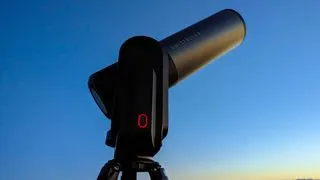 Unistellar eQuinox 2 smart telescope in use against the night sky
Unistellar eQuinox 2 smart telescope in use against the night sky
The Unistellar eQuinox 2 can quickly locate and image night sky objects with minimal effort. (Image credit: Jason Parnell-Brookes)
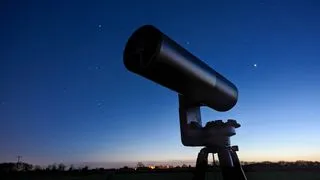 Single power button on the Unistellar eQuinox 2 telescope
Single power button on the Unistellar eQuinox 2 telescope
The eQuinox 2 features a single power button; all other controls are via the app. (Image credit: Jason Parnell-Brookes)
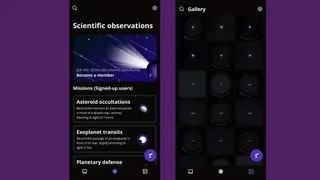 Screenshots of the Unistellar app interface
Screenshots of the Unistellar app interface
All functionalities of the Unistellar eQuinox 2 are accessed and controlled through its accompanying smartphone app. (Image credit: Jason Parnell-Brookes)
Unistellar eQuinox 2 telescope
Best smart telescope: Offers a simplified astronomy experience powered by an intelligent smartphone app.
Specifications
Optical design: Newtonian Reflector
Mount type: Motorized GoTo alt-azimuth
Aperture: 4.49-inches / 114mm
Focal length: 450mm
Highest useful magnification: 400x digital
Lowest useful magnification: 50x optical
Supplied eyepieces: N/A
Weight: 19.8 lbs (9kg)
Reasons to buy
- Visually appealing, streamlined design
- Rapid access to night sky views/images
- Companion app is user-friendly and efficient
Reasons to avoid
- Image resolution is only average
- Alignment/orientation can be difficult in twilight
- Focusing can appear laggy via the app feed
Buy it if:
✅ You live in a light-polluted urban area: The Smart Light Pollution Reduction feature significantly improves visibility in suboptimal conditions.
✅ You prioritize simplicity and ease of use: This all-in-one system requires minimal setup and accessories to observe desired objects.
Don’t buy it if:
❌ You are on a budget: This is an expensive piece of technology, likely pricing out most beginners.
The bottom line:
🔎 Unistellar eQuinox 2: An intuitive motorized smart telescope that simplifies finding objects and viewing the night sky via an app. It’s great for ease of use and urban observing, although the built-in camera resolution is moderate for its price. ★★★★½
The Unistellar eQuinox 2 is a smart telescope that combines the latest technology with a sleek design. It operates primarily through the Unistellar app, featuring only a single power button on the mount. Unlike traditional telescopes, it doesn’t include eyepieces or many standard accessories, as viewing is done via a built-in camera displayed on a mobile device.
The telescope houses a 6.2MP image sensor, which captures and stacks multiple exposures in real-time to create images that appear brighter and more detailed over seconds. This stacking process is particularly beneficial when observing from light-polluted areas, thanks to the Smart Light Pollution Reduction feature that filters out city glow. It’s also very easy to save and share the images you capture.
While this approach differs significantly from traditional visual astronomy, the eQuinox 2 makes stargazing highly accessible, especially for beginners. Setup is quick and easy using the Autonomous Field Detection feature. The app’s intuitive interface allows you to navigate a vast database of celestial objects (37 million stars and over 5,000 deep-sky objects), select targets, and the telescope automatically slews to them. The app even suggests objects currently visible from your location.
This high-tech experience comes at a significant cost, typically around $2,000. It is also relatively heavy, making it less portable than some other models. However, if your budget allows and you prioritize convenience, urban observing capabilities, and easy image capture over traditional viewing, the Unistellar eQuinox 2 is a premium amateur astronomy telescope option.
| Attributes | Notes |
|---|---|
| Design | Streamlined, modern, and self-contained unit. |
| Performance | Rapid GoTo functionality for quickly locating celestial objects. |
| Functionality | App-controlled; alignment works best after dark; imaging is automated. |
Best for deep space
Image 1 of 4
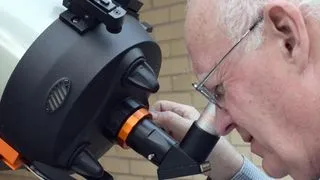 Celestron Advanced VX 8 EdgeHD telescope mounted on an Advanced VX mount
Celestron Advanced VX 8 EdgeHD telescope mounted on an Advanced VX mount
The Celestron Advanced VX8 telescope is bundled with Celestron’s imaging-focused Advanced VX mount. (Image credit: Future/Michael Covington)
 Computerized mount of the Celestron Advanced VX 8 EdgeHD
Computerized mount of the Celestron Advanced VX 8 EdgeHD
The computerized mount finds celestial objects, controllable via hand box or PC connection. (Image credit: Future/Michael Covington)
 Setup for astrophotography with the Celestron Advanced VX 8 EdgeHD
Setup for astrophotography with the Celestron Advanced VX 8 EdgeHD
An astrocamera or DSLR (not included) attaches in place of the eyepiece for photography through the telescope. (Image credit: Future/Michael Covington)
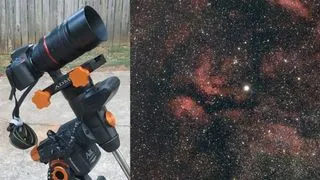 Advanced VX mount with a camera and telephoto lens for deep-sky imaging
Advanced VX mount with a camera and telephoto lens for deep-sky imaging
The Advanced VX mount can support a camera and lens for capturing dramatic deep-sky images. (Image credit: Future/Michael Covington)
Celestron Advanced VX 8 EdgeHD
Best for pinpoint sharpness across the whole field of view, a powerful instrument for veteran astronomers.
Specifications
Optical design: Schmidt-Cassegrain
Mount type: Motorized equatorial
Aperture: 8-inches / 203.2mm
Focal length: 2032mm
Highest useful magnification: 480x
Lowest useful magnification: 29x
Supplied eyepieces: 40mm
Weight: 61 lbs (27.67kg)
Reasons to buy
- EdgeHD optics provide superior performance
- Reliable computerized mount for finding and tracking
- Dovetail mount system offers versatility
- Proven, refined design with long market history
Reasons to avoid
- Requires some knowledge for setup
- Only one eyepiece included
- May need a sturdier mount for serious long-exposure imaging
Buy it if:
✅ You want comprehensive observing capabilities: This telescope excels at viewing all types of celestial objects, from planets to faint deep-sky targets.
✅ You desire a smooth, reliable observing experience: The motorized equatorial mount provides precise tracking.
Don’t buy it if:
❌ You are a beginner: Intended for more experienced astronomers familiar with equatorial mounts and sky navigation.
❌ You need a lightweight telescope: At 61 lbs, it’s one of the heavier options in this guide.
The bottom line:
🔎 Celestron Advanced VX 8 EdgeHD: An optically superb telescope designed for serious amateur astronomers, providing excellent views of all celestial objects. It requires some setup knowledge but is a telescope you are unlikely to outgrow. ★★★★½
Celestron’s EdgeHD technology significantly enhances the performance of Schmidt-Cassegrain telescopes, particularly for astrophotography. Standard Schmidt-Cassegrains can suffer from field curvature, causing stars at the edges of the field to appear blurry. EdgeHD optics correct this, providing a perfectly flat focal plane that matches camera sensors, resulting in sharp, detailed images across the entire frame.
In our review of the Celestron Advanced VX 8 EdgeHD, we were highly impressed by the crisp, clear views delivered by the EdgeHD optics. There was no noticeable optical distortion or false color, and sharpness was consistent from the center to the edge of the field.
The telescope’s Advanced VX mount is robust, supporting up to 30 lbs (13.6kg), ensuring stable support for the optical tube and accessories. The package includes the standard NexStar+ hand controller, a 40mm eyepiece, and access to Celestron’s SkyPortal app and Starry Night Special Edition software.
The Advanced VX mount is specifically designed with astrophotographers in mind. It can track objects past the meridian without needing a meridian flip, features periodic error correction, and includes an auto-guider port for enhanced tracking accuracy.
Views through this telescope are dramatic: Saturn and Jupiter are stunningly detailed, globular clusters resolve clearly into individual stars, all Messier Objects are visible, and under dark skies, galaxies down to 12th magnitude can be observed. It is truly a telescope that supports a long-term commitment to astronomy, representing a significant step up for any serious amateur astronomy telescope user.
| Attributes | Notes |
|---|---|
| Design | EdgeHD optics outperform standard designs, though the system is heavy. |
| Performance | Reliably finds and tracks objects, delivering excellent views across object types. |
| Functionality | Motorized equatorial mount is ideal for photography and serious observing. |
Best for kids
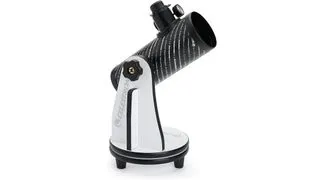 Celestron FirstScope 76 Tabletop telescope on a white background
Celestron FirstScope 76 Tabletop telescope on a white background
The Celestron FirstScope is an affordable tabletop telescope designed to introduce children to sky-watching. (Image credit: Amazon)
Celestron FirstScope 76 Tabletop telescope
Best tabletop telescope, well-suited for young or casual astronomers.
Specifications
Optical design: Reflector
Mount type: Dobsonian
Aperture: 2.99-inch / 76mm
Focal length: 11.81-inch / 300mm
Highest useful magnification: 180x
Lowest useful magnification: 11x
Supplied eyepieces: 4mm, 20mm
Weight: 4.5 lbs / 2.04kg
Reasons to buy
- Highly portable and lightweight
- Very easy to use
- Robust construction
- Low cost for casual or young users
- Fast focal ratio good for wide-angle targets
Reasons to avoid
- Focuser can feel loose
- Some views lack clarity and detail
- Collimation can be challenging
- Finderscope not included
Buy it if:
✅ You want a low-cost introduction to astronomy: It’s an affordable option perfect for casual viewing.
✅ You prefer immediate usability: Arrives fully assembled and ready for use out of the box.
Don’t buy it if:
❌ You need easy object finding: The absence of a finderscope can make locating specific objects frustrating initially.
❌ You expect all accessories included: You’ll need to purchase a finderscope separately.
The bottom line:
🔎 Celestron FirstScope 76 Tabletop Telescope: An ideal entry-level telescope for children or anyone seeking a simple, low-cost way to start exploring the Moon and bright objects. It’s portable and sturdy, though lacks a finderscope. ★★★★
As its name suggests, the Celestron FirstScope 76 is designed with first-time users, particularly kids, in mind. It’s incredibly easy to set up and use, arriving fully assembled and ready to go right out of the box – perfect for impatient young astronomers.
Its compact size and lightweight build (only 4.5 lbs / 2.04kg) make it easy for small hands to handle and move. It’s equipped for basic night sky observations with two included eyepieces (4mm and 20mm). The 76mm aperture and fast f/3.95 focal ratio allow you to spot bright celestial objects and even some fainter deep-sky targets, though detailed close-ups are not its strength. We were impressed by the views of lunar craters it provided, considering its size and price.
Being a tabletop telescope, it requires a surface to sit on for comfortable use, which might be a minor inconvenience depending on your observing location. However, for use indoors near a window or on a patio table, it’s very convenient. If you’re looking for an affordable and straightforward way to introduce the amateur astronomy telescope hobby to a child, the FirstScope is a great solution.
Despite its low price, the Celestron FirstScope 76 is built surprisingly sturdily using durable plastics, giving it a premium feel. The main drawback is the lack of a finderscope, a crucial tool for aligning the telescope and locating objects. Purchasing an inexpensive red dot finder separately is highly recommended to enhance the observing experience for young users.
| Attributes | Notes |
|---|---|
| Design | Good build quality relative to its price; compact and portable. |
| Performance | Provides exciting initial views, though detailed resolution is limited. |
| Functionality | Very easy to set up and use; lacks a finderscope. |
Contributing experts
Telescope FAQ answered by
Dr Gemma Lavender
A contributing expert to Space.com, Live Science, All About Space and more, Gemma is the author of several books including ‘Quantum Physics in Minutes’. She holds a degree in physical sciences, a Master’s in astrophysics and a PhD in computational astrophysics and became fellow of the Royal Astronomical Society in 2011. Gemma is also the Communications and Outreach Officer at the European Space Agency.
Telescope FAQ
How do I choose the right telescope for me?
Choosing the perfect telescope, especially as a beginner, can feel overwhelming due to the technical jargon and numerous options available. However, significant advancements in telescope quality in recent years mean most models perform reasonably well. The key is finding the one that best suits your specific needs.
The most crucial factor is the optical quality, which affects the clarity and sharpness of the views. You also need to consider the aperture size (how much light it gathers), the type of mount (manual, alt-azimuth, equatorial, computerized), and whether you need a portable instrument or a more powerful, larger one for a fixed location. Beginner telescopes are specifically designed to ease newcomers into the hobby.
Beyond the hardware, think about your observing goals: what objects do you want to see (Moon/planets vs. deep space)? Where will you primarily observe from (light-polluted city vs. dark rural site)? Are you interested in astrophotography? Your budget is also a significant factor.
It’s highly recommended to purchase from reputable telescope dealers. They offer reliable products, often with warranties, and their staff typically possess expertise to guide you towards the right decision.
What types of telescope are there?
There are three primary types of telescopes: reflectors, refractors, and catadioptrics.
Reflector telescopes use mirrors to collect and focus light, while refractors use lenses. Catadioptric telescopes combine both mirrors and lenses. Each type has variations; for instance, Newtonian telescopes are a basic type of reflector, often found on simple alt-azimuth or Dobsonian mounts.
For the best value in terms of aperture size, Newtonian reflectors on a Dobsonian mount are often recommended. These are manually operated telescopes and require using star charts to navigate the sky. They gather a lot of light and provide impressive views of many celestial objects. However, larger Dobsonians can be quite bulky and require storage space.
Adding a computerized or equatorial mount increases the cost significantly but offers automated tracking or object finding (GoTo). Computerized Dobsonians or Newtonian telescopes with GoTo capabilities are available, offering convenience at a higher price. A premium Newtonian on a German equatorial mount is much more expensive but offers high precision for tracking and astrophotography.
If portability, ease of use, and convenience are priorities, a smaller refractor (up to 4 inches) or a catadioptric (Schmidt- or Maksutov-Cassegrain up to 5 inches) on a computerized mount are good choices. These are versatile and provide high magnification suitable for observing the Moon and planets.
Achromatic refractors, especially shorter focal length ones, can show false color fringing around bright objects because they don’t focus all wavelengths of light perfectly. Maksutov-Cassegrains are better at correcting chromatic aberration, providing clean, high-contrast views. Apochromatic refractors use special glass to virtually eliminate false color, offering the best refractor views, but they are considerably more expensive.
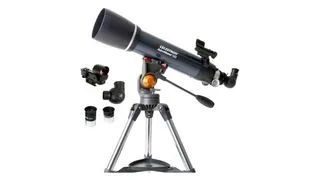 Celestron AstroMaster 102AZ refractor telescope and accessories
Celestron AstroMaster 102AZ refractor telescope and accessories
Refractors are often mounted on simple alt-azimuth bases for easy up/down and left/right movement. (Image credit: Amazon)
How does a refractor telescope work?
Refractors operate by bending (refracting) light through a lens system to form an image, which is then magnified by an eyepiece. With their simple design and low maintenance, refractors are popular, especially for observing the Moon and planets.
A refractor has a main objective lens at the front and a star diagonal with an eyepiece at the back. They are typically mounted on alt-azimuth mounts for easy manual control. This straightforward design makes them relatively easy to manufacture, contributing to their affordability, particularly for novice models.
However, producing high-quality, large-aperture lenses is expensive, so refractors become significantly pricier as the aperture increases. This also makes basic refractors a target for low-quality reproductions from less reputable vendors, so caution is advised when purchasing.
Refractors are known for delivering high-contrast, magnified images, making them excellent for viewing solar system objects like the Moon, planets, and double stars. A refractor with an aperture of 2 inches (60mm) or more offers reasonable views, while 3 to 4 inches (80mm – 90mm) provides better performance for a serious hobby telescope.
A common drawback is chromatic aberration, or “color fringing,” where bright objects show a colored halo because different light wavelengths don’t focus at the exact same point. Achromatic refractors reduce this, while more expensive apochromatic (APOchromatic) refractors use specialized glass to nearly eliminate it. Even with achromatic designs, some purple fringing may remain, but for most casual observing, it doesn’t significantly detract from the experience. Apochromatics offer stunning, color-free views but come at a much higher price. Some high-end apochromatics might even require buying a tripod separately.
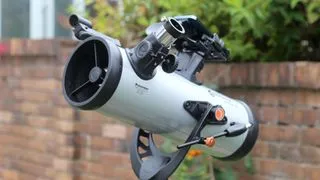 Celestron StarSense Explorer LT 114AZ reflector telescope
Celestron StarSense Explorer LT 114AZ reflector telescope
Reflector telescopes are excellent for low-magnification targets like galaxies and nebulas. (Image credit: Jamie Carter)
How does a reflector telescope work?
Reflector telescopes use mirrors to collect and focus light. The two most common types are the Newtonian and the Dobsonian, which share the same optical principle.
A Newtonian telescope has a large curved primary mirror at the bottom of the tube that collects light. This light is reflected back up the tube to a smaller, flat secondary mirror positioned at a 45-degree angle, which then directs the light out to the eyepiece located near the front of the tube.
Newtonian reflectors can be found on various mounts, including alt-azimuth and equatorial mounts. Equatorial mounts are popular for their ability to track the apparent movement of celestial objects as the Earth rotates, making them suitable for both visual observing and astrophotography. Reflectors are favored by many in the amateur astronomy community for their versatility and the fact that you generally get more aperture for your money compared to refractors. For example, an 8-inch (203.2mm) reflector typically costs less than a refractor of the same aperture, offering greater light-gathering power and resolving capability at a lower price point, making it a common choice for the best amateur astronomer telescope value.
Newtonian reflectors do require periodic maintenance, mainly collimation (aligning the mirrors) to ensure optimal performance. The mirrors may also need cleaning or recoating over time. Choosing a model with protective mirror coatings helps extend their life and ease maintenance.
The Dobsonian telescope is a type of Newtonian reflector on a very simple, easy-to-use alt-azimuth mount. They are known for providing large apertures at low cost and are very intuitive to maneuver. While they don’t track automatically, their simplicity and light-gathering power make them excellent for visual observing, particularly of faint deep-sky objects like galaxies and nebulas. Computerized or GoTo Dobsonians and Newtonians are available for automated object finding, but they are more expensive.
Whatever the mount type, reflectors are particularly effective for wide-field views of extended objects like galaxies and many nebulas.
 Meade Instruments LX65 GoTo catadioptric telescope
Meade Instruments LX65 GoTo catadioptric telescope
The short optical tube of catadioptric telescopes allows for high magnification in a compact package. (Image credit: B&H Photo)
How does a catadioptric telescope work?
Catadioptric telescopes, also known as compound telescopes, combine the optical principles of both refractors (lenses) and reflectors (mirrors) to create a compact and versatile instrument. They use a primary mirror, a corrective lens, and a secondary mirror to produce an image. This hybrid design allows for longer focal lengths and higher magnifications within a relatively short optical tube, making them more portable than traditional refractors or reflectors of equivalent focal length. They are often considered ideal for astrophotography and observing a wide range of celestial targets. Their sealed optical tubes require minimal maintenance. The main drawback is that they tend to be more expensive than similarly sized reflectors or refractors, though shopping around can yield good deals.
The two most common types are the Schmidt-Cassegrain and the Maksutov-Cassegrain.
The Maksutov-Cassegrain (“Mak”) is known for correcting optical aberrations like coma (which distorts star shapes) and chromatic aberration (color fringing). It uses a spherical primary mirror and a deeply curved meniscus corrective lens at the front of the tube. This design provides sharp, high-contrast views, making Maks particularly strong for observing planets, the Moon, and double stars. Maksutov-Cassegrains often feature GoTo mounts, simplifying navigation for the user.
The Schmidt-Cassegrain is another popular catadioptric design, using a spherical primary mirror and a Schmidt corrector plate at the front. Like Maks, they offer compact size and versatility. Schmidt-Cassegrains are also commonly available with GoTo systems. They are excellent for general observation of planetary and deep-sky objects. Corrector lenses can be added to widen their field of view for extended targets.
Both types offer high magnification capabilities in a portable package and are frequently equipped with computerized GoTo mounts, making them excellent choices for a feature-rich amateur astronomy telescope.
 Celestron StarSense Explorer 8-inch Dobsonian red dot finderscope
Celestron StarSense Explorer 8-inch Dobsonian red dot finderscope
A finderscope attached to a telescope helps pinpoint desired objects. (Image credit: Jamie Carter)
What is a finderscope?
A finderscope is a small, low-magnification telescope or sight mounted parallel to your main telescope’s optical tube. Its purpose is to help you locate celestial objects more easily. Because your main telescope typically has a high magnification and a narrow field of view, finding a specific target can be challenging. The finderscope, with its much lower magnification and wider field of view, shows you a larger area of the sky.
To use it, you first align the finderscope with your main telescope. Then, look through the finderscope to scan the broader area of the sky where your target is located. Once you spot the object in the finderscope’s wider view, you maneuver the telescope until the object is centered in the finderscope’s crosshairs or reticle. When it’s centered in the finderscope, it should then be visible in the main telescope’s eyepiece.
Many telescopes come packaged with a finderscope. There are two main types: straight-through (you look directly along the line of sight) and right-angled (you look through an eyepiece positioned at a 90-degree angle). The choice often depends on the type of main telescope you have and ergonomic preference. Some finderscopes also include correcting prisms to show an “erect image” (right-side up and not reversed), which can be less disorienting for beginners compared to inverted or reversed views.
What does aperture, magnification and focal length mean on a telescope?
Understanding these terms is essential when choosing a telescope.
Aperture refers to the diameter of the main light-gathering component of the telescope – either the objective lens (in a refractor) or the primary mirror (in a reflector or catadioptric). A larger aperture collects more light, allowing you to see fainter objects and reveal finer details. For example, a 200mm aperture telescope collects four times more light than a 100mm telescope and can resolve smaller details (e.g., a 1.5km lunar crater vs. a 3km crater) and see fainter stars. Aperture is the most critical factor determining a telescope’s performance.
Focal length is the distance from the main lens or mirror to the point where the light converges and forms a focused image. Telescope focal length is a fixed property of the instrument. It’s typically measured in millimeters. Longer focal lengths generally result in higher magnification when used with the same eyepiece, while shorter focal lengths offer wider fields of view.
Magnification is the amount by which an object appears larger through the telescope compared to viewing it with the naked eye. Magnification is not a fixed property of the telescope alone; it depends on both the telescope’s focal length and the focal length of the eyepiece you are using. The formula is: Magnification = (Telescope Focal Length) / (Eyepiece Focal Length). Eyepieces have different focal lengths, allowing you to change the magnification of a given telescope.
The “useful magnification range” of a telescope is limited by its aperture and the seeing conditions (atmospheric stability). There’s a point where increasing magnification simply magnifies atmospheric turbulence and image imperfections, resulting in a blurry view. A common rule of thumb for the maximum useful magnification is about 50x per inch of aperture (or 2x per millimeter), though this is often limited by atmospheric conditions. Too low a magnification can also be inefficient, as the “exit pupil” (the beam of light leaving the eyepiece) may become larger than your eye’s pupil, wasting light.
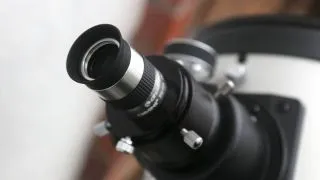 Celestron StarSense Explorer 8-inch Dobsonian eyepiece close up
Celestron StarSense Explorer 8-inch Dobsonian eyepiece close up
Telescope eyepieces can be swapped to change the magnification. (Image credit: Jamie Carter)
Magnification: How do telescope eyepieces work?
Eyepieces are critical accessories that determine the magnification and field of view you experience through a telescope. They work by taking the light focused by the telescope’s main lens or mirror and magnifying that image before it reaches your eye. Every telescope eyepiece has a specific focal length, measured in millimeters (mm). A shorter eyepiece focal length results in higher magnification, while a longer eyepiece focal length provides lower magnification but a wider field of view.
As mentioned before, magnification is calculated by dividing the telescope’s focal length by the eyepiece’s focal length. For example, a telescope with a 1000mm focal length (like a 100mm f/10 refractor or a 200mm f/5 Newtonian) will produce 100x magnification when used with a 10mm eyepiece (1000mm / 10mm = 100).
While you can achieve very high magnifications using very short focal length eyepieces, there’s a limit to how much detail can be resolved. Pushing magnification too high magnifies not only the object but also atmospheric turbulence (seeing) and optical imperfections, leading to a degraded image. High magnification is only practical when atmospheric conditions are very steady and with telescopes on driven mounts that track objects.
A good starting point for an amateur astronomy telescope setup is usually a set of at least three quality eyepieces offering low, medium, and high magnifications. For a 100mm f/10 telescope (1000mm focal length), this might be a 20mm eyepiece (50x magnification, wide field), a 10mm eyepiece (100x magnification, medium field), and a 5mm eyepiece (200x magnification, high power). Lower magnification eyepieces are useful for finding objects and viewing large deep-sky areas, while higher magnification eyepieces are used for detailed views of the Moon, planets, or splitting double stars when conditions allow.
How We Test the Best Amateur Astronomer Telescopes
To provide reliable reviews and recommendations for the best amateur astronomer telescope options, each telescope is thoroughly tested and used under various observational conditions.
Our testing process begins with examining the build quality and design of the Optical Tube Assembly (OTA). This includes assessing the telescope type (refractor, reflector, catadioptric), the construction, size, and the clarity of the optics. We evaluate how easy the telescope is to set up, which is particularly important for beginners, and note any specific requirements like mirror collimation for reflectors.
Accessories such as eyepieces and mounts are evaluated for their functionality and quality. Alt-azimuth, equatorial, and computerized mounts are tested for smooth movement and tracking accuracy, especially for motorized models. The star alignment process, whether it’s simple manual alignment or advanced computerized setup, is thoroughly tested for ease and reliability. We also consider the level of astronomical knowledge needed to operate each telescope effectively.
Portability is assessed by considering the telescope’s weight and size, and how easily it can be transported to darker observing sites away from light pollution. We indicate whether a telescope is best suited as a stationary backyard instrument or a portable travel scope.
The most critical part of our testing is evaluating observational performance. Reviewers use each telescope to observe a range of celestial objects, including the Moon, planets (like Jupiter and Saturn), and deep-sky objects (such as Messier objects). We honestly report on the clarity, brightness, and detail visible, noting any optical aberrations or distortions present in the image.
Our recommendations are based on comparing manufacturer claims against real-world performance. Our team of staff and freelance reviewers comprises seasoned stargazers with years of telescope experience. We also consult with astronomy experts, including those with advanced degrees, to ensure the accuracy and relevance of the information provided regarding telescope use and astronomical concepts. This rigorous process ensures that our guide helps you find the best amateur astronomer telescope that meets your expectations and needs.
Update Log
Recent updates
*Editor’s note 05/08/2025***:** Updated introduction to include details of the May 12 full moon, colorful stars in the night sky (Summer Triangle, Arcturus, Antares) and Saturn’s appearance.
